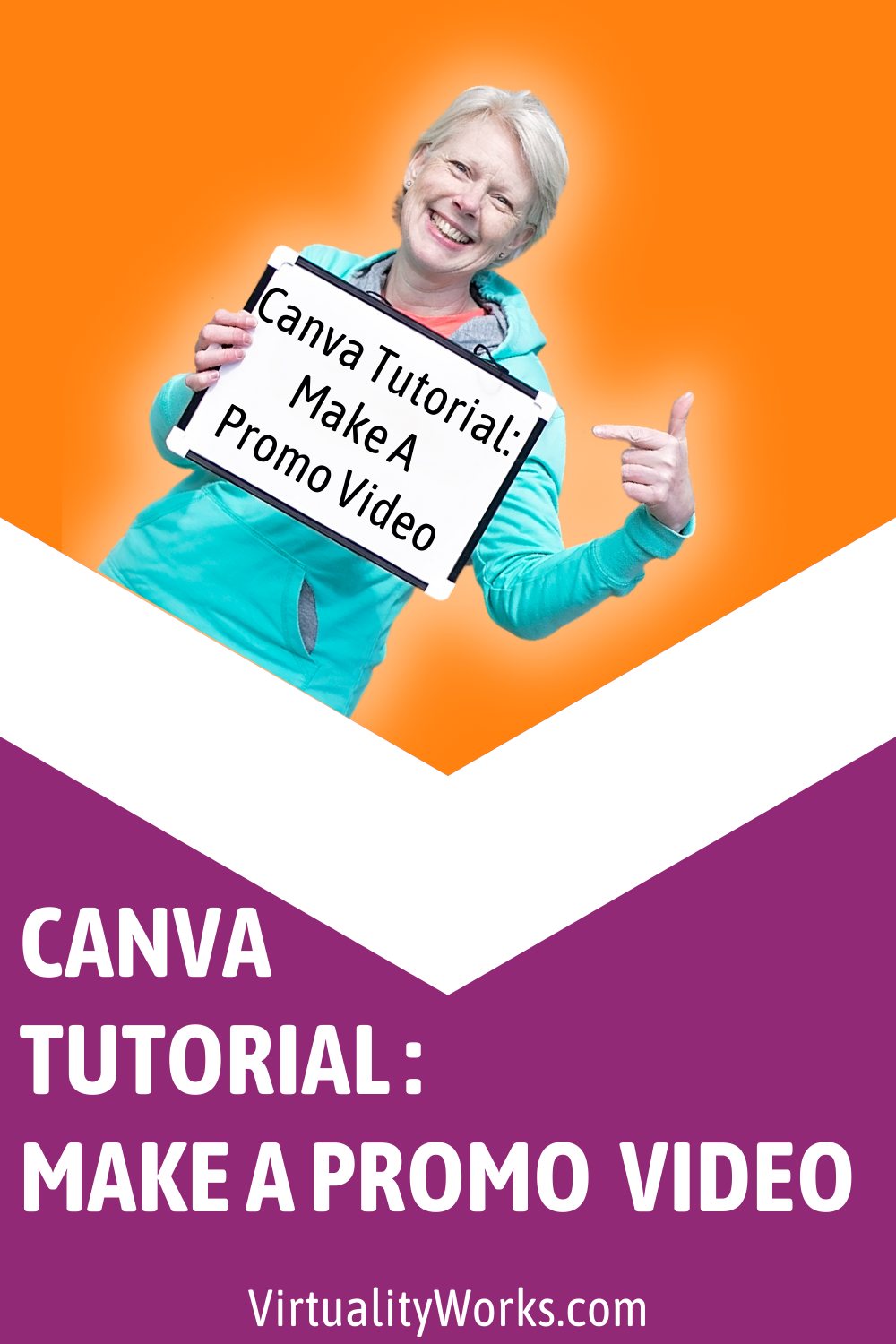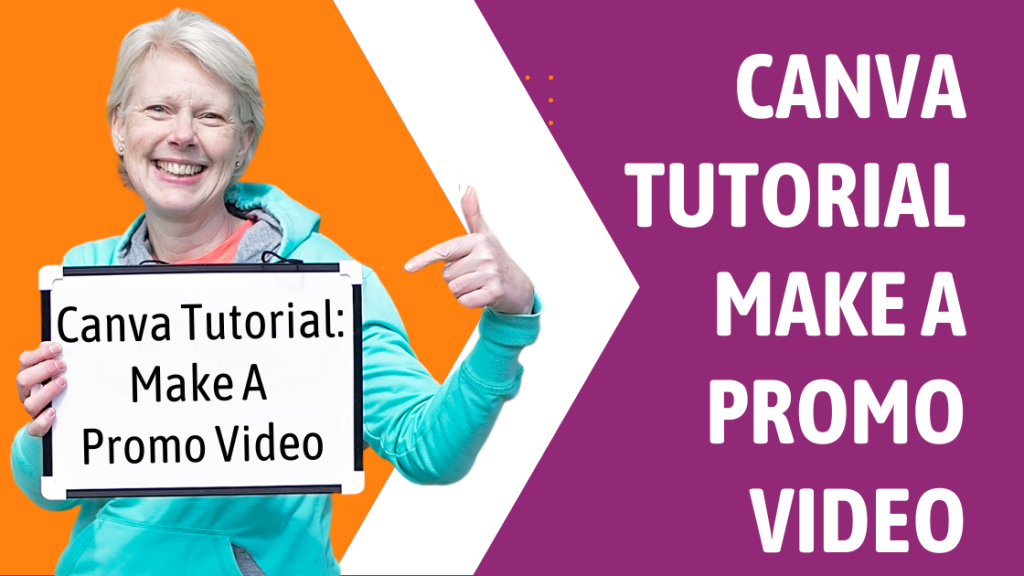In this step-by-step Canva tutorial I explain how you can make a cool & snappy promo video for your course sales page. This is for you even though you struggle making creative videos!
Yes! You can make great promo videos using Canva.
Here are the steps...
I recently added my Canva training course (Create It All Using Canva) into Udemy - the leading global online course marketplace. It's an experiment to see what using Udemy is like, to be honest.
Anyway, it was strongly recommended to add a 2 minute 'promo video' onto the Udemy sales Page. And since the course has a great section about making videos in Canva... I wanted to create the whole video in Canva. Demonstrate how simple skills can be built up into making a cool video!
Plenty of ideas were bouncing around my head, but I knew I wanted the video to be a mixture of me as a 'talking head', mixed with relevant video clips and 'slides' to show information, graphics & perhaps photos. Music would also keep it feeling dynamic. Around 2 minutes was the duration I was aiming for.
It was a fun challenge, and since I made it, I have been asked several times already about the steps involved in making such a video in Canva.
This Canva tutorial explains each step I took and each specific Canva element or technique I used to create it.
First up, here is the video.
These are the steps I followed to make it.

Stage One. Preparation
Step 1.
What is the purpose of the video.
Take the time and ask yourself what is the purpose of the video you want to create.
For my video it was to:
- explain what the course will teach,
- who it's aimed at,
- the benefits of learning better Canva skills,
- who I am & why choose me
- encourage viewers to click thru to the course sales page.
- In around 2 minutes.
So my first top tip is:
Save yourself a TON of frustration and time-wasting by getting very clear about the purpose of your video.
Step 2.
Write the script.
I always focus on the words, the message I want to convey, long before the visuals.
Firstly map out the main points, then expand.
I write my script in a simple text editor such as Microsoft Notepad, then there are no text formatting and hidden characters included if you copy and past the text elsewhere.
Personally, I find it less distracting to write 'notes' in a basic editor. I do this for presentations too - outline the flow and then write the words.
I kept editing, reading it out and timing it so I could arrive at 2 minutes duration.
Get straight into the content. You only have a couple seconds to keep your viewers attention.
Next top tip is:
Yes write it out and polish it, then read it aloud over and over, practicing how it sounds and feels. Don't wing it....
Step 3.
Think about the visual aspects. How will you illustrate the script.
I knew I wanted a mixture of 'talking head' video clips, and voiceover with slides and other 'stock' video clips to keep it visually interesting.
Another 'bonus' of having a mixture like this, rather than only a talking head is that it's easier to have sections where you are giving more information as a slide with voice-over. You can read those bits! You don't have to try and memorise all of what you want to say.
So I printed out my script and started drawing lines through it to make sections for the different visuals. I jotted down some ideas, what video clips I would search for etc.
P.S. I just spotted a cool teleprompter deal on AppSumo which is quite tempting but it's always difficult to maintain eye contact with the camera and check out your notes, so the less you do that, the better you will look on your video. And unless you are really good, and practise a lot, then it will be so obvious that you are reading
Top Tip:
Make sure you are clear on exactly which link or url you want to send people to after watching. Make sure you add the link onto your video so people can always get to the sales page of the thing this video is a promo for. It may get shared around and 'lose' the description that went with it.
I wanted to display my sales page url at the end for 15 seconds.

STAGE TWO. FILMING.
Step 4.
Record the video clips.
This was the only aspect I didn't do within Canva. (but I could have done!)
I chose to use my phone in a brighter location rather than using the webcam on my computer. I was being lazy and couldn't be bothered to get my light out for a couple of second clips.
But, I forgot that I could have used the Canva mobile app and then recorded clips directly into Canva, into a video project. Yes you can record yourself within both the computer version and mobile version of Canva.
[In the Canva mobile app, in your video project, hit the purple + button on the bottom scrolling menu, tap on Gallery, then the Camera icon, select camera or video camera, and record your clip. Hit the purple + each time you want to add another video clip into your project.]
Anyway, I recorded the individual clips directly on my phone camera.
From my earlier preparation, I knew which clips I wanted to memorise and which I could just read cos I would only be using the audio from those.
I also quickly trimmed the clips so they were exactly as I needed them.
This was done simply through my phone Gallery. Picked each clip, hit the pencil to edit and moved the sliders to cut out the unwanted bits at start and end.
Then I put them into my google drive on my phone so I could easily pick them up on my computer, and start the editing process.

STAGE THREE. EDITING.
Now comes the stage where you need patience!
You build up your video in sections (scenes) and in Canva these are treated as 'pages'.
I only do this on my computer 'cos honestly, I can't bear poking about on my phone trying to do things such as video editing.
Step 5.
Creating the 'look & feel' and style of the video.
For the sections where I would be using my talking head video clips, I wanted to present them nicely on the page, so I used a FRAME in the shape of a mobile phone.
There are plenty of different styles of 'device frames' within Canva, and I love presenting video clips within frames, they look so much better!
Using my 2 brand colours, I set up a rectangular GRADIENT , and then set that as the BACKGROUND.
On the right hand side, I added a white circle ELEMENT, offset, and placed the phone frame within that.
Relevant TEXT could then be placed on the left and ANIMATED as required.
Step 6.
Creating each 'scene' (PAGE)
Once the overall design is created, then work through each scene, adding the content.
For the scenes where I wanted a stock video clip with my voice over, I simply overlaid a VIDEO CLIP over my clip of me reading the text.
There are thousands of video clips, use the search and you'll eventually find something suitable. I use a Canva Pro account so I have a much wider selection of stock video clips to choose, but there are still plenty available in the Free level of Canva account.
Step 7.
Use plenty of cool Canva elements.
Once I had the video elements added and the general flow of the video built, then it was time to start adding text, graphics, and plenty of effects.
Here is a list of all the items and techniques I used.
- Animation
- applied to elements, graphics, and text
- at page level and element level.
- using entry and exit settings too.
- Adding video clips into a device frame
- Creating a brand colour gradient and setting it as the background
- Adding an image onto a 'smart mockup' [a device featured within a photograph]
- Overlaying an image with a gradient rectangle and applying transparency so it creates a branded colour filter over the image
- Using image background remover on my photograph and applying the glow effect to it so it 'pops'.
- Using a Text Effect, the Background option, which creates a block of customisable colour around the selected text. More flexible than just adding a rectangle of colour behind some text.
Step 8.
Add background music.
The video was flowing well. Now to add some background music.
Once again, since I have a CanvaPro account, I have a wide selection of audio tracks to choose from. The choice within the Free account is very limited.
Choosing music can take a surprising amount of time to find something that flows at a suitable pace with the video. I wanted something quite fast-paced to match the speed of the video.
The last couple of techniques used to create this video are therefore:
- adding a background music track
- splitting the track so I could add fade out before my speaking comes in
- adjusting the volume level so it is attention grabbing at the start, and a very low-key background for the duration of the spoken sections.

STAGE FOUR. SHARING.
Step 9.
Final production (known as rendering)
When all the changes are in place, then it's time to finish it off and create an MP4 version - the finished video.
This is simply done by hitting SHARE and then selecting MP4.
It can take a while for the finished video to be created.
An important part of this process, if you are using audio tracks provided by Canva, is to ensure that Canva has made a connection to the places where you want to share your video.
This prevents music copyright 'strikes' on the different platforms, by connecting your video and it's music licence with your account, YouTube for example.
Step 10.
Share your video
You now have loads of possibilities for sharing your new 'promo' video, and marketing the thing you are selling.
- Load it into Youtube, or Vimeo
- Embed onto your website,
- Add onto your sales page,
- Include in a blog post,
- Write about it on your newsletter,
- Share on social media.
I hope your new promo video works hard for you.

AND FINALLY.... WELL DONE!
You've pushed your Canva and video making skills forward, and you can feel proud of what you have achieved.
If you are struggling with actually doing this in Canva, then all the skills and confidence you need are included in my new 2022 Canva training course, "Create It All Using Canva".
I am going to add a detailed demo of creating this video as a new lesson within the course.
Of course you can spend many frustrating hours wading through rambling, out-dated, poor quality videos on YouTube.
Or you could:
- value your time and sanity,
- and invest £99
- for high quality, step-by-step, well designed training
- that will gradually build your Canva skills
- so you can easily create a video like this... and more!
You can check out the details here:
P.S Are You A Pinner?

